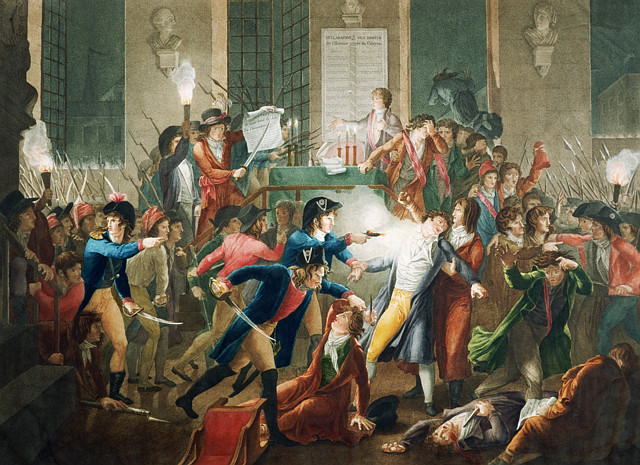Week 10: From Thermidor to Brumaire
Textbook Reading: Censer & Hunt, Chapter 4.
.jpg)
Exporting Revolution
I. The Wars of the Revolution
A. Counter-Revolution in the Provinces
B. The First War of the Coalition (1792-1797)
C. A New Kind of WarMap: The Revolution under Foreign Attack, 1792-1794
Image: Jacques Pierre Brissot (1754-1793)
Image: Joseph Fouché (1759-1820)
Image: Insignia of Royalist Insurgents during the Vendée Insurrection (1793)
Map: Counter-Revolution in the DépartementsImage: Emile-Jean-Horace Vernet, The Battle of Valmy, 1792 (1826)
Map: Republican France and its ‘Sister Republics,’ 1799
Map: The Helvetic Republic, ca. 1798
Map: The Expansion of France, 1791-1811
Image: Raising the Vrijheidsboom in Groningen, ca. 1795II. The Revolution beyond France
A. Exporting Revolution: New Départements and ‘Sister Republics’
B. A Case in Point: The ‘Helvetic Republic’ (1798-1803)
C. Revolution in the Colonies: Saint-Domingue and the Politics of RaceMap: Colonial Saint-Domingue
Image: A pre-Revolutionary Indigo Manufacture
Image: Antoine Barnave (1761-1793), Revolution and Opponent of Slave Emancipation
Image: Nicolas-André Monsiau, L’abolition de l'esclavage par la Convention, le 16 pluviôse an II (1794).
Image: François-Dominique Toussaint Louverture (1743-1803)Image right: Léon Cogniet, La Garde nationale de Paris part pour l'armée, Septembre 1792 (1836) [Detail]. Oil on canvas. 189 x 76 cm. Musée national du Château de Versailles. Image source: L'Histoire par l'Image. On 11 July 1792 the Legislative Assembly, reeling from military defeat and facing the threat of invasion by the armies of Prussia, declares a state of emergency and calls for 50,000 volunteers to join the National Guard. By the end of that summer, the situation had worsened dramatically: the town of Longwy had capitulated to the Prussians, and Verdun was threatened; in late August, the Assembly approved another levy, of an additional 30,000 men. A year later, in August 1793, the National Convention would decree the levée en masse, the general mobilization of able-bodied males. This painting by Léon Cogniet commemorated a conscription of these new soldiers at the Pont-Neuf in Paris. Notice the pedestal in the background: before the Revolution, an equestrian statue of King Henry IV had stood there; its place is now taken by the tricolor banner of the Republic. In general, the atmosphere is one of enthusiasm for the volunteers who would soon defeat the invading armies.
.jpg)
.jpg)
 Thermidor,
Brumaire, and the Revolutionary Legacy
Thermidor,
Brumaire, and the Revolutionary Legacy.jpg)
.jpg)